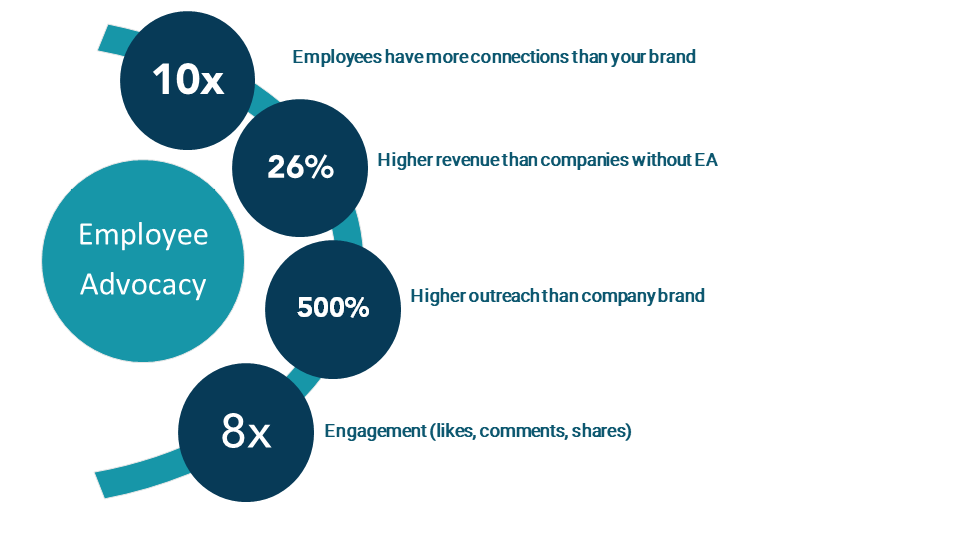Marketing teams have tremendous opportunities in times of change: new topics to discuss and share, new ideas to develop, new strategies to implement. Within the disruption that change provokes, there is a fundamental common element that stays steady more than other aspects – Employee Advocacy.
This strategic concept is going to help you solve many B2B marketing challenges. Behind every change, there’s an opportunity to unlock new strategies. Amongst these opportunities, there are also certain challenges to be resolved, such as the limited amount of content created, employees not leveraging content that is available, sales and marketing divide, management does not see the ROI, etc. But there is good news! Change is more positive than you think.
What is Employee Advocacy
Employee advocacy is encouraging engaged and enthusiastic employees to create brand awareness of the company via their social networks or other communication channels (i.e. Blogging). They do so by ‘liking’, ‘commenting’, ‘sharing’ updates from the organization, and/or participating in topics that are aligned to the company objectives. They ultimately become brand ambassadors through positioning their thought leadership.
Why should Marketing Consider this strategy
From now on, consider the scenario of enterprises using social platforms to increase their brand awareness as part of their online marketing strategy. Let’s dive into why Employee Advocacy is tremendously beneficial for the outcome of such a strategy.
1. Generating Trust
Brand awareness for companies is something that takes time and effort; it is a relationship that is built on trust and it is a long-term investment. When considering Employee Advocacy, there is an accelerator towards that trust: People.
Recent studies show that over 90% of social network users trust content shared by people they know in comparison to less than 40% for sponsored content in social media. More than 85% of social media users consider consumer recommendations to be the most credible form of advertising.
It is simple: If you trust someone, and that person recommends a third party, the chances you trust a third party are higher than if the company were to try and increase brand awareness themselves.
2. Brand Visibility
Many B2B marketing managers experience that the level of engagement with shared insights is higher at the individual level than at corporate one. Thus, getting your employees to contribute to the online brand awareness strategy organically draws toward the desired trust and visibility. Your online marketing strategy becomes more authentic.
One of the strongest convincing points of social media is the NETwork. Let’s consider an example to see the dimension of applying the right Employee Advocacy strategy. In simple terms, your company has 50 employee advocates (brand ambassadors) with 1,000 connections each. Each of them is engaging (liking, commenting, sharing) with content, news, initiatives, etc., that the company is developing. If those 50 employee advocates share 10 insights a month, you are achieving about 500,000 touchpoints with the right Employee Advocacy strategy.
“People listen to and trust people they already know”. – Sociabble.
Social Network Algorithms – LinkedIn
The LinkedIn algorithm is continually changing. The algorithm classifies your content into three different categories (Spam, low quality and good to go). Roughly, LinkedIn gives you 1 point if ‘liked’, 10 points if ‘commented’ upon, and 100 points if ‘re-shared’.
Therefore, it is important to consciously design your social sharing and Employee Advocacy within your Marketing campaign strategy. The more your content is ‘re-shared’ by your employees, the higher is going to score into the social media algorithm, and be consumed by a broader social media ecosystem.
3. Learning from engagement
When Employee Advocacy is executed well, employees are enabling a fantastic opportunity for marketing to tailor their message towards what the customer is demanding. The more the content is ‘re-shared’, the higher the algorithmic score, resulting in an increase of content visibility. Leveraging a variety of social listening tactics (such as analyzing LinkedIn reactions or who is viewing and interacting with your content) will enable marketers to offer more interesting content to the targeted audience.
4. Authenticity
Working with over 100 global companies, we’ve recognized a common challenge under social network Company Pages: the lack of authenticity. It has now become something that is seen as a normal challenge. Why? Simple answer. The shared content is perceived as corporate content when there is an abundance of shares coming from Company Pages daily. It is critical to consider how to humanize the content in this competitive digital environment.
Employee advocacy stands for ‘transforming’ corporate content into more authentic and personalized content.
As stated above, the likelihood of trusting someone from your network is higher than trusting a faceless company. Start implementing your own EA strategy accordingly to build up a positive brand awareness that comes from the heart of your company: your employees.
5. Metrics (YES! Employee Advocacy can be proven by numbers)
Our experience with coaching international enterprises and thousands of employees has taught us that Employee Advocacy is highly effective to achieve some of the goals that B2B marketing pursues. If after reading this article you aren’t convinced why Employee Advocacy can tremendously help your digital marketing strategy succeed, take a look at these statistics:

The importance of incorporating an Employee Advocacy strategy is clear now. The next question is: How do we do it? Changing or creating something new in your digital marketing strategy is not always an easy task. It implies a change of mindset and behavior as well as having the right tool(s) to make it happen. From our expertise, there are several ways to begin your first steps towards Employee Advocacy.
In our next article, we will share with you how you can start designing and implementing the right EA strategy to optimally achieve your current business objectives. Sharing content is effective but getting your employees to share and engage with your content is where the magic happens.



